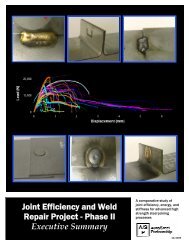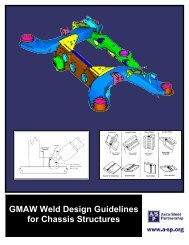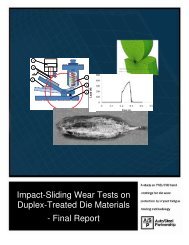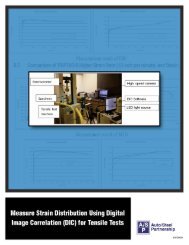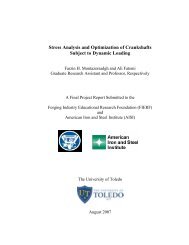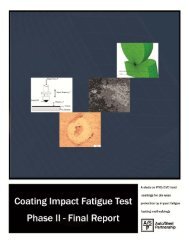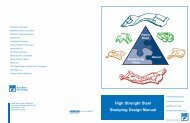Light Truck Frame Joint Stiffness Study Phase 1 Final Report
Light Truck Frame Joint Stiffness Study Phase 1 Final Report
Light Truck Frame Joint Stiffness Study Phase 1 Final Report
Create successful ePaper yourself
Turn your PDF publications into a flip-book with our unique Google optimized e-Paper software.
LITERATURE SEARCH<br />
<strong>Joint</strong> <strong>Stiffness</strong><br />
The research evaluation of joint stiffness and rotation focused on the definition of joint stiffness and where<br />
to calculate it. Different methods of measuring stiffness were employed based on where and how to<br />
measure the deflection in order to calculate the rotation. Liew defined their method to measure the<br />
rotation based on the “deformation of the connection elements, not deformation of the column and beam<br />
members” (Liew et al. 1997). Some assumptions were made analyzing the joints and calculating stiffness:<br />
the material is linear elastic, in-plane deformations are negligible, and the deformations are small and<br />
mainly due to bending. With these assumptions, the stiffness is calculated as K=M/θ . The rotation θ and<br />
applied moment M are based on the instantaneous center of rotation (Rao et. al, 1983).<br />
For the sensitivity study of the joint, the joint parameters, member thickness and shape are varied to<br />
measure how sensitive the joint is to a particular parameter. Although actual stiffness prediction<br />
experiments were not found in the literature, relevant information was found regarding stress<br />
concentration factors (SCF). “From the raw SCF numerical values, parametric equations were obtained at<br />
the six critical locations for the three load cases under consideration. The parametric equations were<br />
obtained using MATLAB, which is capable of performing a non-linear data fitting by using different least<br />
square methods” (Chiew et al.,1996). For the stiffness analysis, a similar technique of finding the critical<br />
locations can be used for data fitting parametric equations to the joint stiffness. The parametric equation<br />
for the joint sensitivity can also be calculated analytically through a design of experiments.<br />
Lessons Learned<br />
<strong>Joint</strong> Definition:<br />
• The length of the structure surrounding the joint interface should be sufficiently long to minimize the<br />
influence of the end conditions (Chiew, 1996)<br />
• <strong>Joint</strong>s should contain all the unique characteristics (i.e. local reinforcements, extended flanges,<br />
access and lightening holes), minimize the inclusion of surround structure, and have boundaries<br />
defined in plane of the crosssection of the beam member (Rao et al., 1983)<br />
• The joint stiffness has a large effect on system dynamic performance (offshore platform) (Chen &<br />
Zhang, 1996). <strong>Joint</strong>s must be well discretized to measure the stiffness using dynamic methods<br />
(Becker et al., 1999)<br />
• <strong>Joint</strong> stiffness has a greater effect on system stiffness when the joint stiffness is decreased than when<br />
it is increased, suggesting that current body joints are designed near a “threshold” value (Chen, 1998)<br />
Fixture/Test Setup:<br />
• Designing the rig’s stiffness to ensure that the deflection of the rig when the specimen is loaded is an<br />
order of magnitude lower than that of the specimen (Yeoh S-k et al. 1995)<br />
• Bolt torque and weld quality are critical in measuring maximum capacity of the joint (Davison et al.,<br />
1987)<br />
Test Procedure and Load Cases:<br />
• The specimen should first be subjected to an incremental static loading on one axis, and the strains<br />
checked for linearity and zero drift to indicate shake-down of residual stresses (Yeoh et al., 1995)<br />
<strong>Report</strong>: A/SP-005-1 <strong>Light</strong> <strong>Truck</strong> <strong>Frame</strong> <strong>Joint</strong> <strong>Stiffness</strong> <strong>Study</strong> 8



